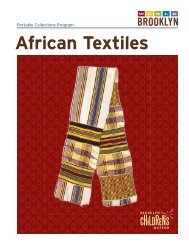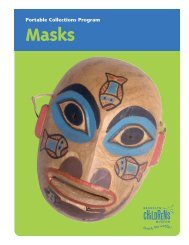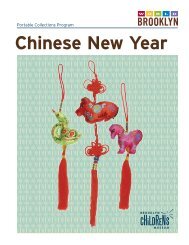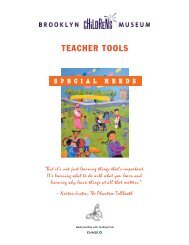Telling Stories Through Objects - Brooklyn Children's Museum
Telling Stories Through Objects - Brooklyn Children's Museum
Telling Stories Through Objects - Brooklyn Children's Museum
Create successful ePaper yourself
Turn your PDF publications into a flip-book with our unique Google optimized e-Paper software.
■ INFORMATION FOR THE TEACHER ■<br />
How to Handle <strong>Museum</strong> <strong>Objects</strong> How to Look at <strong>Museum</strong> <strong>Objects</strong><br />
Learning to handle objects from the <strong>Museum</strong>’s<br />
permanent collection with respect can be part of<br />
your students’ educational experience of the case.<br />
Please share these guidelines with your class, and<br />
make sure your students follow them in handling<br />
objects in the case:<br />
• Students may handle the objects carefully under<br />
your supervision.<br />
• Hold objects with two hands. Hold them by the<br />
solid part of the body or by the strongest area<br />
rather than by rims, edges or protruding parts.<br />
• Paint, feathers, fur and fibers are especially<br />
fragile and should be touched as little as possible.<br />
Remember that rubbing and finger oils can be<br />
damaging.<br />
• Do not shake the objects or the plexiglass cases<br />
they are housed in.<br />
• Temperature differences, direct sunlight, and<br />
water can be very harmful to certain objects.<br />
Please keep the objects away from radiators and<br />
open windows, and keep them secure.<br />
TELLING STORIES THROUGH OBJECTS 3<br />
<strong>Objects</strong> have the power to fascinate people with their<br />
mere physical presence. Holding an object in their<br />
hands forms a tangible link between your students,<br />
the artist who made it, and the artist’s homeland.<br />
This sense of physical connection makes it easier for<br />
students to think concretely about the ideas and<br />
concepts you introduce to them in your lessons.<br />
<strong>Objects</strong> also have the power to tell us about their<br />
origins and purpose, provided we are willing to look<br />
at them in detail and think about what those details<br />
mean. Encourage your students to examine an<br />
object carefully, touch it gently and look at its<br />
design and decoration. Have them describe its<br />
shape, size, and color. Ask them questions about<br />
what they see, and what that might tell them. For<br />
example:<br />
• How was the object made? What tools did the<br />
artist need?<br />
• What materials did the artist use? Where might<br />
he or she have gotten those materials?<br />
• How is the object decorated? What might the<br />
decorations mean?<br />
• What does the object tell you about the person<br />
or people who made it?








